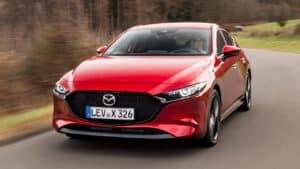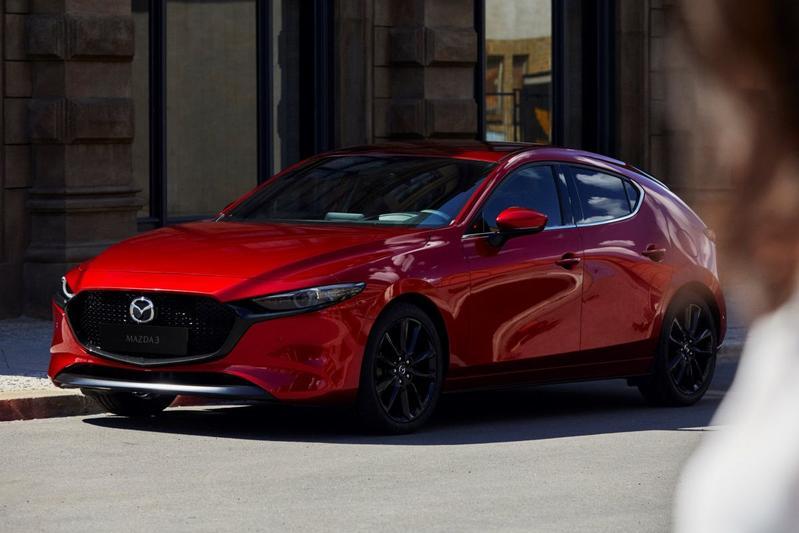
Car buyers are being hit by a wave of new technology, with a lot designed to reduce emissions and lower fuel use. Everything from electric vehicles to hybrids and hydrogen.
Now, from Mazda, there’s quirky but clever tech unique to the brand that comes out of left field to make driving as simple as it used to be – and with fuel economy we previously only dreamed about.
So, we’ve put Mazda’s innovative new SkyActiv-X engine up against one of the two ‘regular’ petrol unit in the Mazda3 small car to find out what all the fuss is about.
Perhaps you didn’t know Mazda’s right up there amongst the world’s best and most tech-rich engine builders.
From the days of the rotary engine (don’t fret: it’s still around and itching for a reappearance) to passenger-car diesels and silky V6 petrols, Mazda hasn’t been sitting around watching the world go past.
Now it’s actively marketing its SkyActiv matrix that encompasses all the important bits from the chassis through to the engine and transmission, with the aim of creating lower emissions, efficient fuel consumption and a big sprinkle of fun.
The two regular petrol engines (2.0L and 2.5L) in the regular Mazda3, for example, are branded SkyActiv-G (‘G’ for gasoline - and there’s a ‘D’for the diesels).
The latest SkyActiv tech is the SkyActiv-X engine - an outwardly simple 2.0-litre four-cylinder petrol engine that sips like a lawnmower and stretches the performance limit way beyond its cubic capacity.
Mazda claims it’s a world first by making a petrol ignition (that is, its combustion is fired by spark plugs) that has the ability to automatically run like a diesel engine (without spark plugs) and get all the oil-burner’s renowned fuel economy benefits.
In the X, the compression ratio is higher - to 15:1 - which allows it to become a compression-ignition engine (like a diesel, the heat of the compression ignites the fuel-air mixture in the combustion chamber), so allowing a much leaner (less petrol) mix that of course saves fuel.
It will revert to a spark-ignition system when needed, mainly coasting and low-effort driving where some power is required. But more importantly, any fuel in the combustion chamber will be burnt and not end up heading out the exhaust pipe.
It also doesn’t emit lots of hydrocarbons (soot) - a diesel call sign - yet has the oil-burner’s locomotive low-speed torque for quick off-the-mark acceleration. All up, Mazda claims 30 per cent more torque with up to 30 per cent less petrol use than its non-X 2.0-litre sibling.
If your head now hurts, just think of it as a clever way to get the best of all worlds without going the full stretch to plugging in an electric vehicle.
Mazda sells the SkyActiv-X engines alongside its traditional petrol engines in the Mazda3 and the CX-30 small SUV, with more models expected to follow.
Mazda markets it along with the ‘i-stop’ (stop-start system) and ‘mild hybrid’ wording but, as a hybrid, it’s a bit of a misnomer as it doesn’t share power duties with the petrol engine.
The implication here is that it uses an electric motor to start the petrol engine - particularly in its stop-start duty - and regenerate energy back to the battery.
It does, however, have a battery in the boot with the responsibility of storing energy gathered from regeneration (coasting and braking) and then offering this to the starter motor (as in operating the i-stop system).
SkyActiv-X promises reduced running costs, but its tech comes at a price premium over the less-endowed siblings.
New tech is always a good thing, especially if you’re lowering missions while making minimal impact on your delicate bank balance. But is the high tech worth the extra bucks? We find out.
Mazda offers the Astina flagship grade in the Mazda3 hatch and sedan, both with a normal 2.5-litre petrol engine and the X engine. So, it’s ripe for a comparison.
In the right corner we have the familiar Mazda3 SkyActiv-G (2.5L) - a sedan or hatch that’s been around for almost 20 years and through a generation of motorists. It’s neat, simple, affordable and easy to drive. People love them, so it’s a go-to model for new- and used-car buyers alike.

In the left corner is the Mazda3 Sky-Activ-X. It looks exactly like the Mazda3 you’ve loved for years, but don’t be deceived. Under the bonnet is a unique engine that will save you big on fuel while making no difference to your driving style and ownership experience.
Exterior details are identical, except for the SkyActiv-X badge, as is the interior. The comprehensive safety features, all the infotainment equipment and comfort specifications are also identical.
The difference is the extra $3000 of the X engine. Is it worth it?
This has a 2.5-litre four-cylinder petrol engine rated at a healthy 139kW at 6000rpm and 252Nm of torque at 4000rpm. This all heads through a conventional six-speed torque-converter (that is, not a CVT or dual-clutch) automatic to the front wheels.
Mazda claims an average of 6.6 L/100km from a 51L tank, indicating a theoretical range of 773km.
Break the fuel economy down and it will average 8.6 L/100km in the city (for a range of 593km) and 5.4 L/100km on the open road (for an indicated range of 944km).
The X has a smaller 2.0-litre petrol engine as its base, which is similar to the engine used in some other Mazda models. It also has a conventional six-speed automatic transmission and front-wheel drive.
Mazda gives this an average of 5.5 L/100km for a range of 927km from its same 51L fuel tank. In the city, the average is 6.5 L/100km (for a range of 785km), and in the country, 4.9 L/100km which should get a range of 1041km.
There’s nothing outwardly magical here - the X engine is simply more efficient and will save money in both city and country routes.
Cover 12,000km a year at the claimed fuel average and the normal Mazda3 will cost incur an annual bill of $1109 (91RON petrol at $1.40/L).
Drive the same distance and the X will cost $924 a year (same fuel and cost/litre). The annual difference is $185.
On fuel alone, the $3000 difference in purchase price of the car will mean it will take a whopping 16.2 years to reach neutrality of the purchase price.
As reported, motorists are currently averaging a trade-in time of about every three years. On this alone, the X may be a technical whizz, but it’s not going to manufacture extra dollars for your wallet.
But don’t dismiss this outright. For a city-suburban owner, the X-engined Mazda3 will be $353 a year cheaper, and while in the country, it will save the owner $84 a year.
Mazda’s capped-price service costs are for the life of the vehicle and require annual visits at up to 12,000km.
The standard Mazda3 SkyActiv-G (2.5L) will cost $1011 for three years, slightly cheaper than the X version that costs $1065. Nothing much in that.
The warranty and the premium roadside assistance program are for five years and unlimited distance.
Add the fuel and the service costs over three years and it comes to $4338 for SkyActiv-G (2.5L) and $3837 for the SkyActiv-X.
We love the technology and the fact that Mazda showcases its cleverness in making a thrifty family car while all other manufacturers are falling over themselves to concentrate on electric drive.
Sure, Mazda has its own EV, but it still thinks there’s spark in the bowsers.
But when it comes to your wallet, thinking you’re making a great contribution to preserving your savings isn’t actually as big as you may think.
In its favour, the X engine is a lovely powerplant with seamless low-end torque and an effortless sense of acceleration and overtaking - all the hallmarks of a diesel.
The three-year saving of $501 is enough to have an annual restaurant dinner with your partner. And to have a bit of a smug attitude to being party to a barely known engine design that is defying a global trend away from fossil fuels.